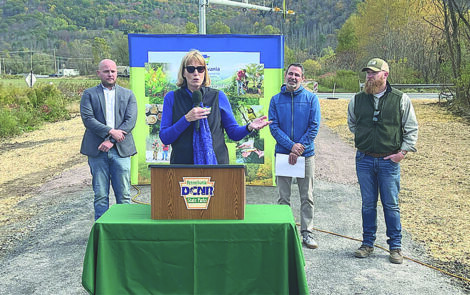Chesapeake Bay water quality report card should spark us
As it splashed around in the bottom of a small translucent Tupperware container between being weighed and carefully measured, a hellbender regurgitated pieces of crayfish it recently had harvested from the nearby creek.
Obviously, this hellbender had eaten well, especially considering the drastic increase in size of this specific creature over the past several years according to data collected by Dr. Peter Petokas at the site – one of a few dwindling pockets of ideal hellbender habitat in a watershed once thriving with the species.
“The high-quality habitat that these creatures need, which includes really large rocks that they spend their entire lives beneath, we’ve lost a lot of that due to a variety of factors including excessive stream sediment and loss of water quality,” said Petokas. “There are only small patches of it left in our entire (Susquehanna) watershed.”
Ironically, on the same day I was able to join Petokas for some of his field work with hellbenders at this site in our watershed, the University of Maryland Center for Environmental Sciences released its Chesapeake Bay and Watershed Report Card for 2023/24.
The bay received a C-plus grade, its highest mark, up from a straight-C in last year’s report card. The greater Chesapeake Bay watershed (of which we are a part) scored a C in this year’s report card and within the Susquehanna’s watershed, the highest score was the West Branch, which received a C-plus.
The study, which has been done annually for 17 years, looks specifically at nutrient levels, such as total phosphorus and total nitrogen, as well as dissolved oxygen, chlorophyll-A, water clarity and diversity within the benthic community.
The Susquehanna River drains 27,500 square miles of land, including nearly half of the land area of Pennsylvania. Much of that is very rural farmland. Growing up on a small dairy farm, I know how difficult it can be to make ends meet while leaving the smallest possible environmental footprint for those downstream.
Since 2021, Pennsylvania has invested more than $580 million into supporting farm conservation, restoring watersheds, and other on-the-ground projects to improve local water quality. This includes more than $61 million in Growing Greener grants, more than $92 million in farmland preservation and conservation projects, and nearly $9 million to plant forest buffers and restore urban tree canopy.
So, any sign of potential improvement in water quality downstream from us should be celebrated. We need to show people their investments (both financial and physical) are making a difference.
However, it is also critically important to keep things in context. Headlines since the report card came out have referred to the improvements in the bay/watershed as “historic” and while the C to C-plus grade may be a first for the Chesapeake Bay in this specific scoring system, suggesting “historic water quality improvements” as a whole in the Chesapeake Bay watershed is potentially misleading.
The report itself, beyond the scoring, does go on to share that “Pennsylvania will not meet its 2025 commitments to achieve an estimated 42 percent of the nitrogen-pollution reduction and 64 percent of the phosphorus reduction.”
And, it is important to remember that this study is looking at nutrient loads and sediment but there are also so many other issues that complicate water quality within our aquatic ecosystem, including, but not limited to:
• Abandoned mine drainage
• PFAS
• Microplastics
• Legacy coal islands in our river
• Mercury levels in macroinvertebrates
• Salinity impacts from road over-application
• Pharmaceuticals and endocrine disruptors
• Unique chemicals, such as trichloroethylene, related to industrial mishaps and superfund oversight
• Numerous invasive threats such as rusty crayfish, flathead catfish, snakeheads and New Zealand mud snails, just to name a few.
Plus, figuring out how all these and other issues react with each other, enhancing and compounding the intricacies of the issues they cause within the aquatic ecosystem in each ripple including us.
So, yes, it is cool to know that the Chesapeake Bay and the greater watershed may have seen a slight bump in certain aspects of water quality and that the cooperative effort of people from lawmakers to farmers likely played a part in that.
But I struggle to celebrate a partial letter-grade bump in water quality in the Chesapeake Bay when all I keep picturing is that hellbender from the plastic tray as we carefully put him back under the large rock where he lived his whole life right here in our collective backyard waterway.
This column was written by Middle Susquehanna Riverkeeper John Zaktansky in response to the recent release of the University of Maryland Center for Environmental Sciences 2023/24 Chesapeake Bay and Watershed Report Card.




